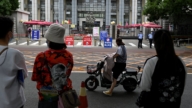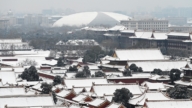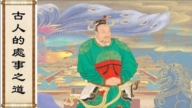【新唐人2013年12月19日讯】长江是中国和亚洲的第一大河,中国的“三峡水坝工程”完工后,长江流域最大的水利工程就是“南水北调”。日前专家指出,三峡和南水北调工程,严重破坏了长江的生态,目前,长江缺水现象严重,江里已经无鱼可捕。
中共耗资5000亿元人民币投入的“南水北调工程”,是长江流域最大的水利工程,工程规模和难度,超过“三峡水坝工程”,但是,专家评估认为,工程对于长江流域的环境,将造成“浩劫”。
“南水北调”的构想,是把长江流域的水资源抽调一部分,送到华北和中国西北,从而改变中国“南涝北旱”的现象,和北方地区水资源严重短缺的局面。工程分为东线、中线和西线三条线路。
大陆媒体《瞭望东方周刊》日前报导﹕“三峡、南水北调工程影响生态,长江无鱼可捕。周刊专访科学院院士曹文宣,他是目前中国资历最老的长江生态系统专家之一。”
曹文宣在专访中列举了近年来为保护长江生态而进行的一系列努力,但他评价“效果都不是很大”,具体表现在,国家一级重点保护动物—-白鳍豚,已经“功能性绝灭” 另一种一级保护动物—-白鲟,已经10年不见踪影。
而长期关注三峡工程的中国环保活动人士戴晴指出,自从“三峡工程”的泥沙问题提出来之后,当局开始在长江的上游筑坝,筑了坝,栏了沙,同时也栏了水,于是就造成了长江水短缺。戴晴说,这一事实被当局给隐瞒了。
中国环保活动人士戴晴:“本来大自然安排的好好的,河流流过什么地方,那个地方应该有什么样的农业,然后那面的人是以什么样的生活,可是,人类以为自己掌握了技术,有了一点小小的技能,就完全按照自己怎么样得到更多的利益,就来改变自然。”
2001年,北京取得2008年奥运会的举办权,为了给“北京奥运会”提供水源,时任党魁的江泽民立即批准“南水北调工程”,并在隔年的2002年年底正式开工。
但是工程进展一直不顺利,因为工程违背可持续发展的基本原理,而大量移民人数大大超过了规划。因此,尽管投资一再追加,工期却一推再推。2008年北京奥运会就没有喝上“南水北调工程”的水。
戴晴:“南水北调现在说的好听,其实我们大家都知道,中线的南水北调是非常紧缺的,这个水,不能说百分之百无水可调,但是想用南水北调中线的水,来解决北京的水短缺,用我的观点几乎是没有可能的。”
曹文宣在专访中表示,“南水北调西线”对长江上游的生态环境影响会更大。相对而言,长江上游的生态系统更为脆弱,水源区的生产、生活都会受到影响,需要慎重对待。他还说﹕“南水北调中线”的工程“影响大”。
分析指出,“南水北调中线工程”现在面临的最大技术问题,就是“水源地的水量不足”,水位不够高,无法满足调水和自流要求。
而正当中共中央和国务院面对“南水北调工程”水源不足的问题束手无策时,中共国家发改委却又在2011年7 月,批准了陕西“引汉济渭工程”,也就是引汉江水向渭河调水,规划每年可调15亿立方米水。
曹文宣认为,“引汉济渭”工程,要把汉江三分之一的水量调往北方地区,汉江中下游的水量则大量减少,而现在汉江的水已经不多了。”
旅居德国的中国水利专家王维洛则认为,“南水北调各线工程”都将对长江的中下游环境造成浩劫性的影响。例如东线工程调水,将导致长江河口地区的土壤盐渍化等问题,而中线工程则将造成武汉、湖北地区难以估量的损失。
戴晴则认为,中共前党魁毛泽东说的“人定胜天”,结果导致中国目前到处出现自然灾害,而这些灾害,归根到底都是人类自己造成的。
采访编辑/常春 后制/孙宁
Natural Disasters Inflicted By The Water Diversion Project
The Yangtze River, is the largest river in China and Asia.
After the Three Gorges Dam construction, the river is now
undergoing the massive infrastructural Water Diversion Project.
Experts have recently pointed out that both the
construction of dams and the Water Diversion have severely
damaged the ecology of the Yangtze River.
The Yangtze River is running short on both water and fish.
The South-to-North Water Diversion is a 500 billion yuan
project of the Communist regime.
It is the largest water project with the scale and complexity
far exceeding that of the Three Gorges Dam.
The environmental impact assessment shows the project is
bringing catastrophe to the Yangtze River.
The Water Diversion Project was to divert part of the Yangtze
River water to the north and northwest;
the drought area of China.
The project includes a Western, a Central and an Eastern route.
The Oriental Outlook magazine recently reported in an interview
with China’s senior ecologist, Cao Wenxuan, of the Institute of
Hydrobiology at the Chinese Academy of Sciences.
Cao Wenxuan listed the series of efforts in recent years
to protect the ecology of the Yangtze River, and their
effectiveness as “not good."
Examples are: Rare fish such as the Yangtze dolphin is
functionally extinct,
and the Chinese sturgeon has disappeared for 10 years.
Dai Qing is an environmentalist having long-term observed
China’s Three Gorges Dam.
She indicates that since the sediment matter of the
Three Gorges Dam was silted up,
the regime started to build a dam in the upper reaches of the
Yangtze River to block the sand and silts, but also the water.
That has caused the water shortage of the Yangtze River,
and “a fact concealed by the authorities,” says Dai Qing.
Dai Qing, environmentalist: “Nature had arranged it well
at the beginning, where the water should flow, what type of
agriculture to develop, and life style of the people.
With technology, human beings thought they can manage it
the way they’d like to and so they started to change nature."
In 2001, Beijing received the hosting rights for the 2008
Olympic Games.
To provide water for the Beijing Olympics, the then Communist
party leader Jiang Zemin immediately approved the Water
Diversion Project to be started by end of 2002.
The project has met many obstacles because of violating the
principles of sustainable development and
the exceedingly large population of migrants.
There were constant budgetary over-runs,
constant delays and postponements.
The water from the project never made it to
the 2008 Beijing Olympic Games.
Dai Qing: “The Water Diversion sounds nice. But we all know
the fact that the water in the Central Route is very scarce.
There is water to be diverted, but to solve the water shortage
in Beijing, to me it is almost impossible."
Cao Wenxuan indicated in the interview that the Western Route
will have an even bigger impact on the ecosystem of the
upper reaches of the Yangtze River.
It will further weaken the ecosystem and affect productivity
and life in the reservoir.
He added, “The Central Route will have a major impact.”
Analysis has pointed out that the biggest technical problem of
the Water Diversion is insufficient water in the reservoir.
The water level is so low that it can not sustain
diversion and natural flow.
While no solution to this water shortage of the Water
Diversion Project has been found,
the Communist regime approved yet another water diversion
project in July 2011.
The Han-Wei Water Diversion Project in Shaanxi Province
will move water from the Han to the Wei River and by 2030
will be drawing 15 billion cubic metres of water from
the reaches of the Han River.
Cao Wenxuan said, “The Han-Wei Water Diversion will divert
one-third of Han River water to the north.
The water in the middle and lower reaches of the Han River
has reduced significantly.
Han River has not much water left.”
Water expert Wang Vero believes that the overall water
diversion projects are an environmental catastrophe to the
middle and lower reaches of the Yangtze River.
For instance, the Eastern Route will lead to soil salinization
in the Yangtze River estuary region, and the Central Route
will bring incalculable damages to Hubei Province.
Dai Qing stresses that, former Communist Party leader
Mao Zedong’s “Man Will Conquer Nature” has led to wide-
spread natural disasters in China.
All these natural disasters, as it turns out,
are man made.
Interview & Edit/Chang Chun Post-Production/Sun Ning





























